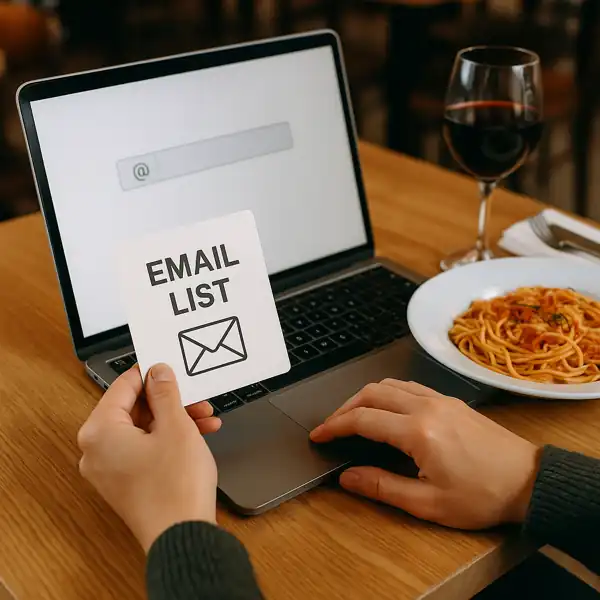In the fast-paced world of restaurant marketing, trends come and go—but one strategy remains consistently effective: building an email list. While social media platforms for restaurants evolve and algorithms shift, email marketing continues to deliver exceptional return on investment (ROI) for restaurant owners who use it wisely. Whether you’re a cozy neighborhood café, a trendy brunch spot, or a high-end dining destination, email list building can become your most reliable channel to nurture loyal customers and boost sales.
In this guide, we’ll explore why building an email list is crucial for restaurants, how to do it effectively, and the best practices to ensure long-term success. By the end, you’ll have a blueprint that turns casual visitors into raving fans.
Why Email List Building Matters for Restaurants
Unlike social media, where your reach depends on algorithms and paid ads, your email list is a direct line of communication to your audience. It’s owned media—you control when, how, and what you send. That’s powerful.
Restaurants thrive on repeat customers. A diner who visits once and leaves happy is great, but one who returns monthly is even better. Building an email list gives you the opportunity to create that kind of relationship.
Email marketing also outperforms other digital channels in open rates, click-through rates, and conversions. According to industry data, the average ROI for email marketing is $42 for every $1 spent. This makes it a cost-effective tool for increasing reservations, promoting specials, and filling tables during slow hours.
How to Get Started: The Fundamentals
Building an email list doesn’t happen by accident. It’s a deliberate effort that requires a blend of in-person tactics, online strategies, and compelling offers. Before launching your first campaign, you need to set up the right infrastructure.
Start by choosing a reliable email marketing service such as Mailchimp, Klaviyo, or Constant Contact. These platforms let you collect and manage email addresses, segment your audience, design beautiful emails, and track performance.
Next, make sure your website has an email capture form that’s visible and appealing. Ideally, it should be placed in key locations like your homepage, blog, reservation page, or as a pop-up after a few seconds of browsing. Add value by offering something in return—a discount, free appetizer, exclusive menu sneak peek, or entry into a giveaway.
If you use a reservation system like OpenTable or Toast, ensure it integrates with your email marketing tool. This allows you to automatically collect emails from guests who make bookings or order online.
On-Site Tactics to Capture Emails
Your physical location is one of your most valuable assets for list building. Every person who walks through your doors is a potential subscriber. Here’s how to turn diners into subscribers without being pushy.
Start by training your staff to invite customers to join your VIP list. When presenting the bill, they can casually mention a promotion tied to email sign-up—perhaps a 10% discount on their next meal or a free dessert on their birthday.
Place signage at key touchpoints—near the host stand, restrooms, or checkout counters. Use table tents or flyers that encourage sign-up via QR codes. These can link directly to your email form or a mobile-friendly landing page.
If you offer Wi-Fi, use a captive portal that requires customers to enter their email before accessing the internet. Make sure to disclose that they’ll be added to your mailing list and offer an opt-out if necessary to comply with privacy regulations.
Online Strategies to Grow Your List
Your restaurant’s digital presence can amplify your list-building efforts far beyond your physical location. Your website, social media, and third-party platforms can all become magnets for email sign-ups.
Begin with your website. Every page should have a clear call to action inviting visitors to join your list. Use pop-ups, sticky bars, or exit-intent forms to catch users before they leave. Offer compelling lead magnets, such as an exclusive recipe ebook, a VIP coupon, or early access to upcoming events.
Social media is another powerful tool. Promote your email list in your Instagram bio, Facebook posts, and TikTok videos. Run a giveaway where participants must enter their email to join. Highlight the benefits—like first access to seasonal menus, subscriber-only discounts, or behind-the-scenes content.
You can also collaborate with food influencers or local bloggers. Ask them to promote your sign-up form in exchange for a meal or a sponsored feature. Their audiences trust their recommendations and may be more likely to opt in.
Google Ads on Facebook or Instagram can be used for list building too. Target local users with an offer that encourages email submission. The cost per lead is often lower than traditional advertising, and you own the contact data.
What to Offer: Give People a Reason to Subscribe
No one joins an email list just for fun. Your potential subscribers need a compelling reason—something that feels exclusive, valuable, or time-sensitive.
Think about what your ideal customer would find irresistible. Is it a limited-time discount? Early access to seasonal items? Invitations to wine tastings or cooking classes? Maybe it’s a birthday club that rewards them each year. Tailor your offer to match the tone and style of your restaurant.
Restaurants often succeed with one of the following incentives:
-
A discount or freebie: “Sign up and get 10% off your next visit.”
-
A chance to win: “Enter your email for a chance to win dinner for two.”
-
Loyalty perks: “Our subscribers eat first. Get early access to reservations and menu drops.”
Remember, the value doesn’t end with the sign-up. Make sure your ongoing emails consistently deliver on the promise of exclusivity and benefits.
Segmenting Your List for Better Results
Once your list starts growing, you’ll want to segment it. This means dividing your subscribers into groups based on their behavior or characteristics. Doing so allows for more targeted messaging—which leads to higher engagement.
For example, you might segment your list by:
-
Location: if you have multiple locations, send local promotions.
-
Frequency: distinguish regulars from first-time diners.
-
Order type: separate dine-in guests from online customers.
-
Preferences: send vegetarian promos to people who ordered plant-based dishes.
With segmentation, a seafood special goes to seafood lovers, and a brunch discount goes to weekend visitors. The more relevant your message, the better your open and click-through rates.
Writing Emails That People Want to Open
Your subscribers gave you something valuable—their contact info. Now it’s your job to respect their inbox and make every email count.
Start with the subject line. This is the make-or-break moment. Be specific, catchy, and authentic. Instead of “July Newsletter,” try “Free Guac This Weekend 🌮” or “The Secret Ingredient in Our New Pasta (Hint: It’s Local)”.
Use the body of the email to deliver a mix of value, personality, and clear calls to action. Keep the design clean and mobile-friendly. Include high-quality images of your food, and link to menus, reservations, or ordering platforms.
Great email ideas for restaurants include:
-
Weekly specials
-
Seasonal menus
-
Behind-the-scenes videos
-
Customer stories or reviews
-
Chef’s tips or recipes
-
Holiday hours or event invites
Don’t email too often or too infrequently. One to four times a month is a good range. Track engagement and adjust your frequency based on what your audience prefers.
Avoiding Common Mistakes
While email list building is powerful, it can backfire if done poorly. Avoid these common pitfalls that frustrate subscribers or limit your growth.
First, never add people to your list without consent. Whether it’s through your Wi-Fi portal, booking platform, or a printed sign-up sheet, always make it clear what they’re signing up for. Comply with data regulations like GDPR and CAN-SPAM.
Second, don’t send irrelevant content. If your emails always push hard sales or ignore customer preferences, people will unsubscribe. Value-packed, personalized emails keep readers engaged.
Third, avoid outdated contact lists. Periodically clean your list by removing inactive users or confirming interest. This keeps your open rates healthy and your email reputation strong.
Finally, test and optimize. Use A/B testing to try different subject lines, layouts, and send times. Monitor your open rates, click rates, and unsubscribes to learn what works best.
Measuring Success and Scaling Up
As your email list grows, you’ll want to track how it’s performing. Most email platforms provide robust analytics. Look at open rates (aim for 20%+), click-through rates (2%+), and unsubscribe rates (keep it under 1%).
More importantly, track real-world results. Are more people using your email promo codes? Are reservations going up after campaigns? Are online orders increasing during email specials? If so, your strategy is working.
As you gain confidence, you can begin experimenting with automation. For example, send a welcome series to new subscribers. Or a re-engagement campaign to inactive ones. Set up birthday emails with special offers, and use cart abandonment emails for online ordering systems.
If your list grows into the thousands, consider integrating it with your CRM or loyalty system to build a full customer profile. This allows for even deeper personalization and stronger lifetime value.
Some reflections
Email list building isn’t just a trendy tactic—it’s a long-term asset for your restaurant. With the right approach, it can drive repeat business, increase customer loyalty, and keep your brand top-of-mind. It doesn’t require a massive budget or a technical background—just consistency, creativity, and a genuine desire to connect with your guests.
So start today. Add that sign-up form, craft a great offer, and send your first email. Your future regulars are only one message away.








